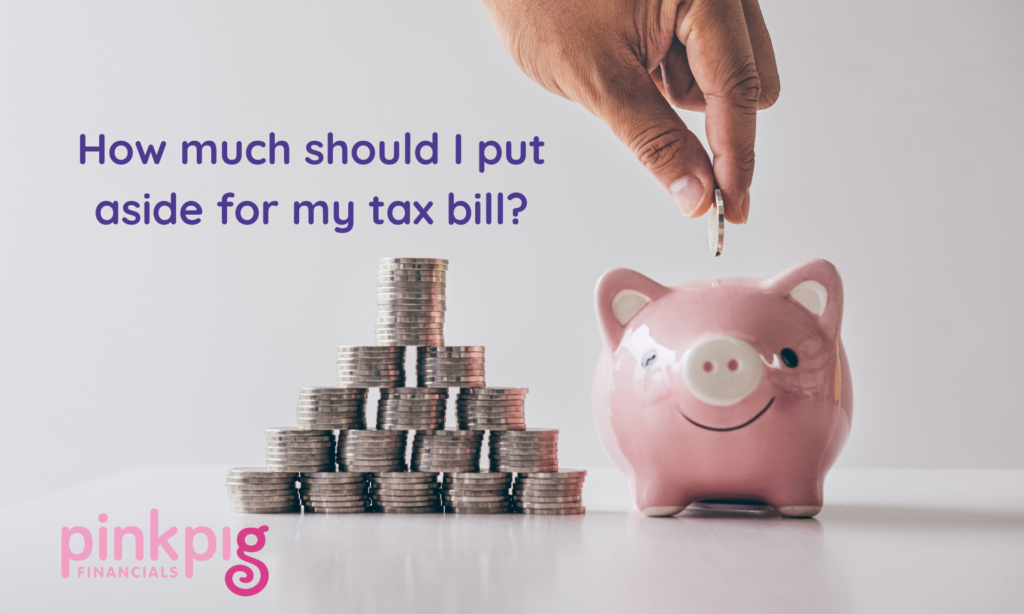How much should I put aside for my tax bill?
Whether in business or personal life, we all know that ‘sinking stomach feeling’ when there’s less in the bank than you were expecting, or you get a ‘failed Direct Debit’ notification ..
One of the biggest times we see this in business is when it comes to tax bills – whether it be corporation tax, self-assessment or VAT. And the reason for this is not because ‘the business (you!) didn’t make enough money’. It’s because these are delayed payments, and so the sales you’re paying that tax on could have happened over a year ago, and that money is long gone, spent on something else.
The solution to this problem is, of course, put the money aside, in a separate bank account, if possible, as soon as it comes in. But how will you know how much to put aside, and when? Here is our step by step guide! (If you’re a sole trader, just skip down to point 4!)
1. VAT
The most obvious rule of thumb is ‘put aside 20% of each sale’. Your invoice itself tells you how much VAT you have charged on that sale.
Of course, the good thing with VAT is that all of your VAT-inclusive purchases will offset your sales VAT, and therefore decrease what you owe to HMRC. Therefore, putting 20% aside of each and every sale will whole-heartedly more than cover what you owe.
Depending on how your cash flow works, you may not be able to set aside the whole 20% of each sale. That’s okay, because, like we said, some of that will be reduced by your purchases. The best thing to do in this situation, is to have an idea of your expenses incurred on that sale, reduce the amount by the VAT on those purchases, and then set that aside.
Using this method is where management accounts which allow you to track sales in great depth, will help you!
2. Corporation Tax
Corporation tax is payable on the profits for your whole year, after the accounts have been done and all allowable deductions have been included. So, throughout the year, it is tough to have an exact figure for this (and, of course, this is subject to some change starting April 2023). However, we would suggest that you put this aside monthly, based on your YTD figures.
Take a few minutes at the end of each month to look at your Profit & Loss, and see what your Net Profit for your financial year so far is. Transfer the relevant percentage (19% – 25% depending on your profit) of that amount into another account to save for your corporation tax bill.
Again, with this method you will be more than covered, meaning not only are you saving for tax, but there will be a fund sat there for a rainy day too.
Blog suggestion: Changes to UK Corporation Tax Rates – What You Need to Know
3. Director’s Self-Assessment Tax Returns
This one is probably the easiest to predict – if you’re a director of a limited company, that is.
For the majority of our clients, we will have you on the tax-free salary throughout the year, meaning that essentially, you decide how much you will pay based on how much you take in dividends. Again, this rate will have changed if you’re reading after April 2023, but bear in mind your tax-free dividend allowance, and then put aside 8.75% of anything above that.
One thing to be mindful of is HMRC’s ‘payments on account’ system. If you owe more than £1000 in personal tax, they will also ask for a payment on account to offset against the next year’s tax. This hits the hardest in year 1, and after that, should even out a bit more, as you’ve always already paid most of the coming year’s tax.
4. Sole Trader Self-Assessment Tax Return
As a sole trader, things are slightly different for you. We’re going to be advising essentially a bit of a mix of steps 2 and 3. You’re probably going to want to be checking your Profit & Loss at the end of each month. For the majority of people, you have that tax-free amount of £12,570, so, until your profits go over that, you’re okay.
Once they creep over that level, at the end of each month, calculate what profit you have over and above that threshold, and set 20% of that aside. And, of course, once that savings pot gets bigger than £1000, there will be payments on account for you to take into consideration too.
Again, this will be hardest in year 1, and after that, take solace in the fact that you’ve essentially covered a big chunk of next year’s tax.
As MTD for ITSA comes into play in the next year, your mandatory quarterly submissions will give you the kick up the bum you need to at least know where you are each quarter, if not every month.
How we can help
This may have cleared things up … but for some of us, we may now be sat worrying about remembering to do all of this!
We know!
We know you didn’t start your business to sit and worry about your numbers! Our clients all receive a Quarterly Summary as standard which includes year-to-date estimates, so you do know what to put aside, as well as upcoming payment reminders, in advance of the actual day it’s due, giving you time to get things in order.
This service can be upgraded to monthly too, so that at the end of each month, you have peace of mind knowing you’ve put aside what you need to.
If you’re ready to take some of the stress out of running your business, and get some of those helpful nudges about what to set aside during the year, get in touch with us to have a chat!

